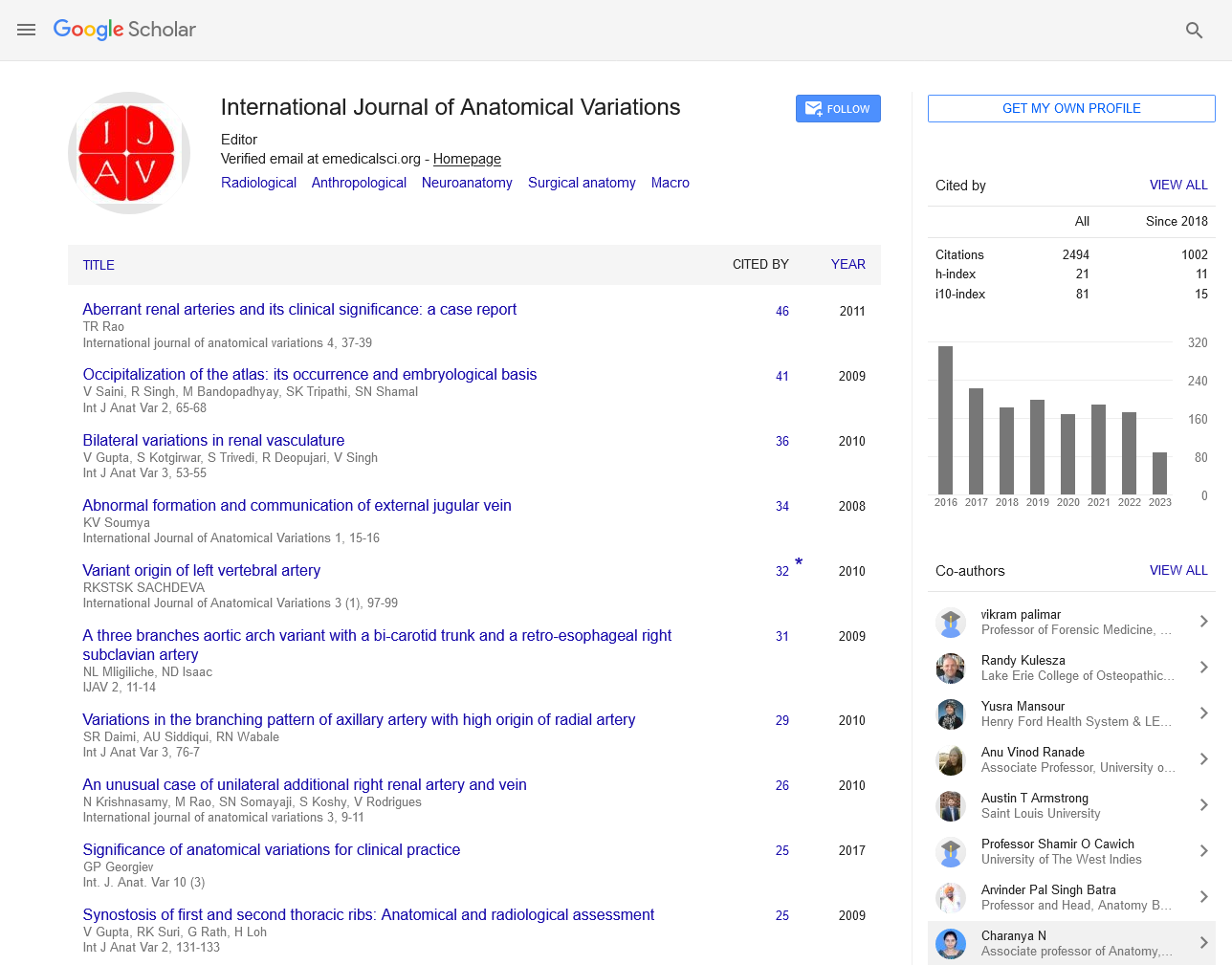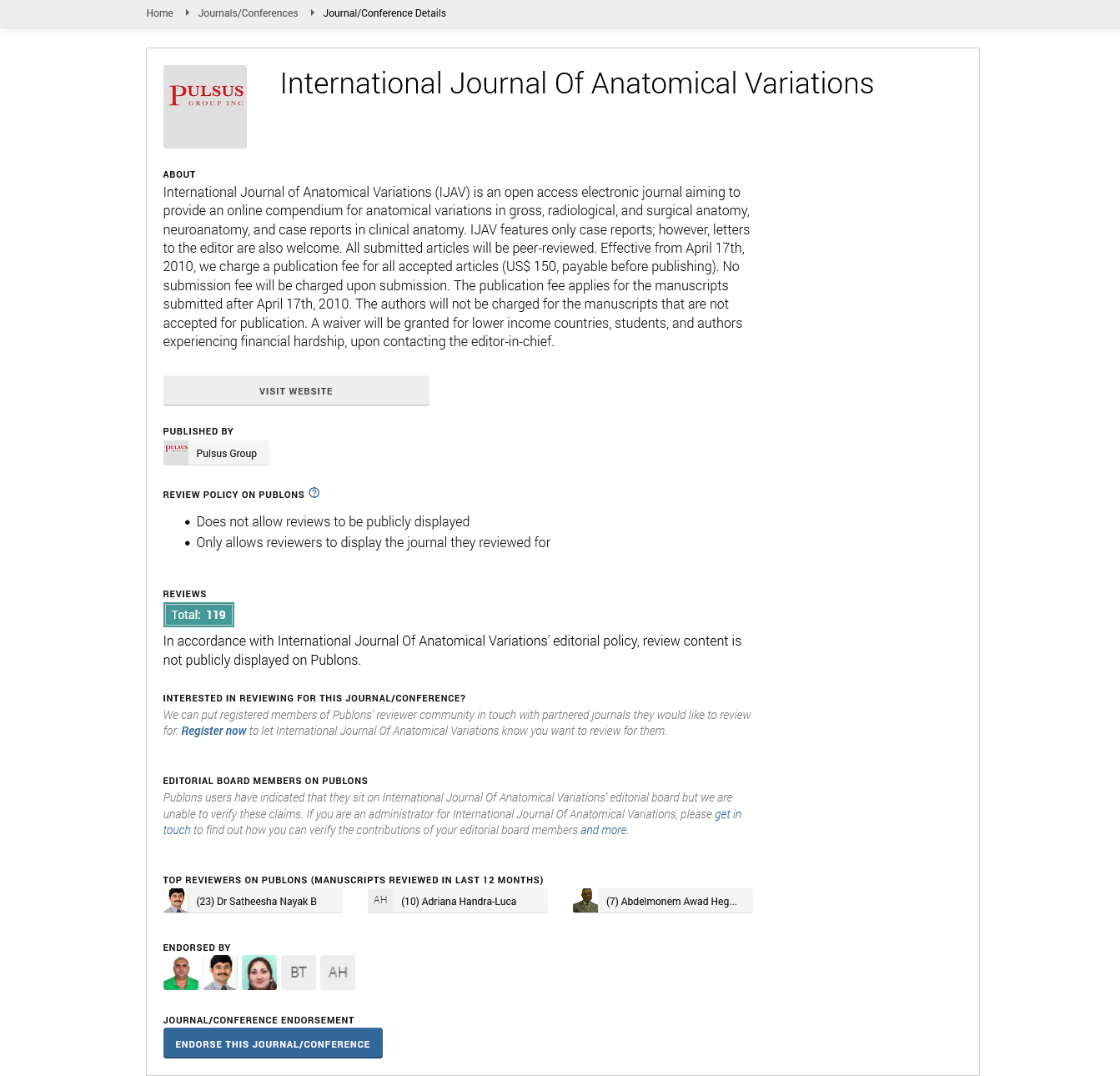A Comprehensive Overview of Human Anatomy: Structural Complexity and Functional Integration
Received: 01-Mar-2025, Manuscript No. ijav-25-7637; Editor assigned: 04-Mar-2025, Pre QC No. ijav-25-7637 (PQ); Reviewed: 19-Mar-2025 QC No. ijav-25-7637; Revised: 26-Mar-2025, Manuscript No. ijav-25-7637 (R); Published: 30-Mar-2025, DOI: 10.37532/1308 4038.18(3).494
Citation: Kumar A. A Comprehensive Overview of Human Anatomy Structural Complexity and Functional Integration. Int J Anat Var. 2025; 18(3): 760-761.
This open-access article is distributed under the terms of the Creative Commons Attribution Non-Commercial License (CC BY-NC) (http://creativecommons.org/licenses/by-nc/4.0/), which permits reuse, distribution and reproduction of the article, provided that the original work is properly cited and the reuse is restricted to noncommercial purposes. For commercial reuse, contact reprints@pulsus.com
Abstract
Human anatomy, the cornerstone of medical and biological sciences, provides critical insights into the structure and organization of the human body. This article offers a comprehensive examination of human anatomy, detailing the major systems, their interconnectivity, and the significance of anatomical knowledge in clinical and research contexts. The work emphasizes the integration of form and function, the advances in anatomical research, and the technological innovations that have transformed our understanding of the human body.
INTRODUCTION
Human anatomy, derived from the Greek word Anatomie dissection, is the scientific study of the morphology of the human body. It is fundamental to the fields of medicine, physiology, and numerous health-related disciplines [1]. Anatomical knowledge enables healthcare professionals to diagnose and treat illness effectively and serves as the basis for surgical and medical interventions. Human anatomy stands as a cornerstone of medical science, offering a profound insight into the structural intricacies and functional unity of the human body. This field explores the elaborate architecture of organs, tissues, and systems that collectively sustain life, maintain homeostasis, and enable adaptability in diverse environments. From the microscopic networks of cells to the macroscopic coordination of organ systems, human anatomy reveals a design that is both remarkably complex and functionally integrated. This comprehensive overview aims to illuminate the multifaceted organization of the human body, emphasizing the interdependence of its components and the sophisticated harmony that underpins physiological function [2]. By delving into the layers of anatomical knowledge, we not only appreciate the marvel of human structure but also lay the groundwork for understanding health, diagnosing disease, and advancing medical innovation.
HISTORICAL DEVELOPMENT OF HUMAN ANATOMY
The evolution of anatomical science spans several millennia. Ancient Egyptian and Greek scholars, including Hippocrates and Galen, contributed early models of human anatomy based on animal dissection. The Renaissance period marked a turning point with Andreas Vesalius's De humani corporis fabrica (1543), establishing modern anatomical science through human dissection. In the modern era, advancements in imaging technologies such as MRI and CT scans have further revolutionized anatomical study [3].
HUMAN BODY
Comprising 206 bones, the skeletal system provides structure, protection for vital organs, and facilitates movement. It also serves as a reservoir for minerals and houses bone marrow for blood cell production [4]. This system includes over 600 muscles, responsible for voluntary and involuntary movements. Skeletal muscles work with bones to produce motion, while smooth and cardiac muscles perform essential involuntary functions. Central (brain and spinal cord) and peripheral components regulate bodily functions through electrical signals. It governs sensation, motor control, cognition, and homeostasis. This system, consisting of the heart, blood vessels, and blood, distributes oxygen, nutrients, and hormones while removing metabolic wastes. It facilitates gas exchange through the lungs and airways. Oxygen enters the bloodstream, and carbon dioxide is expelled. A complex series of organs including the stomach, intestines, liver, and pancreas break down food, absorb nutrients, and eliminate waste. Comprised of the kidneys, ureters, bladder, and urethra, it regulates water and electrolyte balance and removes nitrogenous wastes. This system of glands secretes hormones that regulate growth, metabolism, and sexual development. Responsible for producing gametes and facilitating reproduction. It also influences secondary sexual characteristics through hormonal control. A network of vessels and nodes that aids in immune response and fluid balance, protecting the body against pathogens. Includes skin, hair, nails, and exocrine glands. It protects against environmental hazards, regulates temperature, and provides sensory information [5].
INTERDEPENDENCE AND INTEGRATION
While each system has distinct functions, they are highly interdependent. For example, the muscular and skeletal systems work in concert for movement, while the circulatory system transports nutrients absorbed by the digestive system. This interconnectedness ensures homeostasis and efficient functioning.
CLINICAL RELEVANCE OF HUMAN ANATOMY
Accurate anatomical knowledge is indispensable in clinical practice. Surgeons rely on detailed anatomical maps during operations; radiologists interpret body structures through imaging; and pathologists understand disease through changes in anatomy. Moreover, anatomical variants must be recognized to avoid misdiagnosis or surgical error.
ETHICAL CONSIDERATIONS
Cadaveric dissection, while crucial, raises ethical issues regarding consent, dignity, and body donation. Institutions must follow strict ethical guidelines and ensure respectful treatment of donor bodies.
CONCLUSION
Human anatomy is a dynamic and intricate field central to all medical sciences. Understanding the structure and function of the human body not only advances medical knowledge but also enhances patient care. As technology evolves, so too does our capacity to explore, visualize, and apply anatomical insights in diverse and meaningful ways.
REFERENCES
- Park K-M, Yang S-S, Kim Y-W, Park KB, Park HS, et al. Clinical outcomes after internal iliac artery embolization prior to endovascular aortic aneurysm repair. Surg Today 2014; 44:472-477.
- Patel SD, Perera A, Law N, Mandumula S. A novel approach to the management of a ruptured Type II endoleak following endovascular repair of an internal iliac artery aneurysm. Br J Radiol. 2011; 84(1008):e240-2.
- Szymczak M, Krupa P, Oszkinis G, Majchrzycki M. Gait pattern in patients with peripheral artery disease. BMC Geriatrics. 2018; 18:52.
- Albulescu D, Constantin C, Constantin C. Uterine artery emerging variants - angiographic aspects. Current Health Sciences Journal 2014; 40:214-216.
- Osher M, Semaan D, Osher D. The uterine arteries, anatomic variation and the implications pertaining to uterine artery embolization. J Vasc Interv Radiol 2014; 25:S143.
Indexed at, Google Scholar, Crossref
Indexed at, Google Scholar, Crossref
Indexed at, Google Scholar, Crossref
Indexed at, Google Scholar, Crossref






